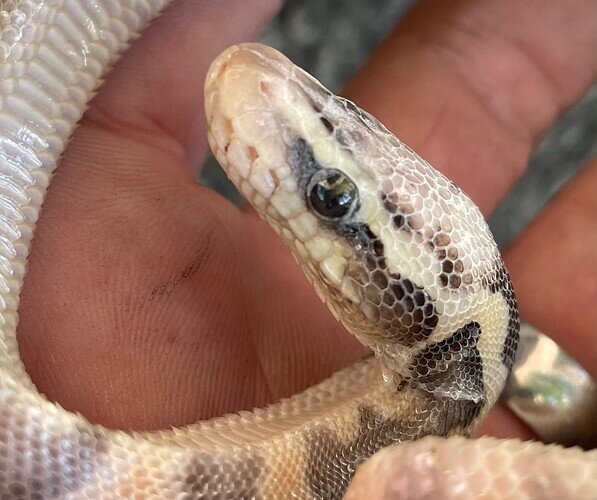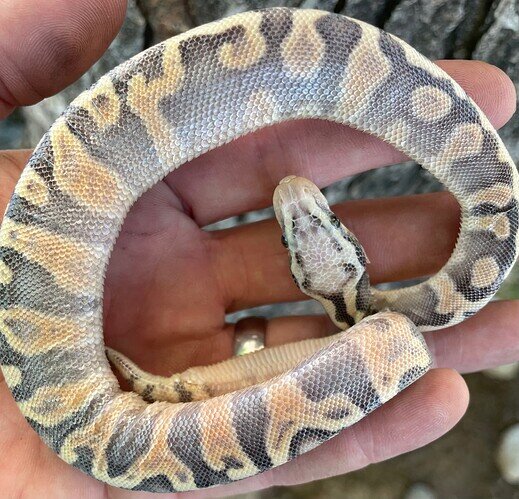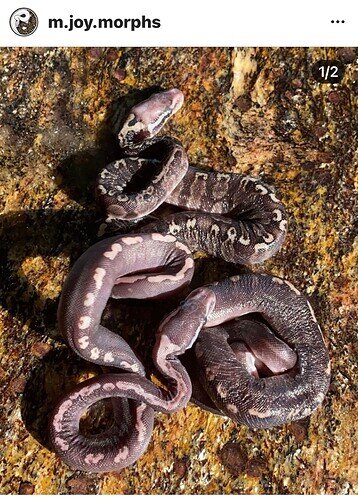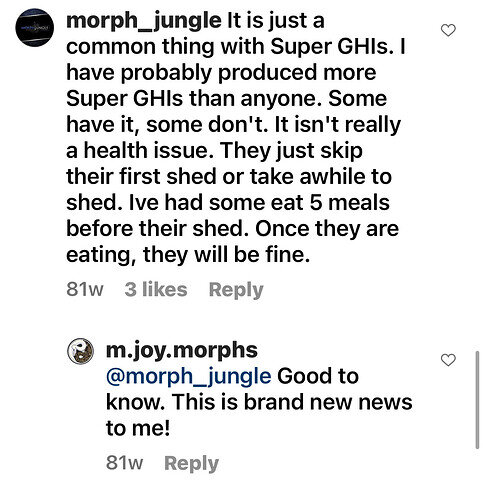Well much of the problem is 99% of the time, our first hand experience is a small sample size. Far too small to make any claims as concrete fact. I hatched 3-4 clutches of spiders before I had my first corkscrewer. After a few clutches I could of easily made the same claim of temps helping and said my limited experience agrees with others, I could claim the one corkscrewer was a fluke. As my sample size has grown over the years and more occasional cork screwers produced, I’ll say lower temps (at least at 86 ) don’t make a bit of difference. There nothing to suggest lower than that would matter either.
Only thing I’ve seen a actually reduce the wobble is when going from bad husbandry to good husbandry. That I’ve seen multiple times help out a wobbling snake and I mean bad trainwreck to barely noticable. Husbandry makes a world of difference.
Really? I honestly didnt know. That is awesome! Two experts sharing info with us, so cool, and we don’t even have to take out student loans. 
See, this kind of information which can only come from a large data sample is exactly what is needed. Of course the people giving you flack don’t get that. It’s just tragic that someone has to do it. I can’t imagine how many times that must have sucked.
I don’t have spider in my collection, not for any real moral reasons, they are being kept in a controlled environment, it’s not thunderdome, the wobble isn’t going to result in starvation, no I just felt we weren’t experienced enough to be able to give a special needs snake the appropriate care and I didn’t want to have to deal with yammer heads about it when selling offspring, since we’ve reached that level. As if a breeder can’t tell when the gene has been inherited, it’s really overpowering in expression. I think I’ve only seen a few animals where I wasn’t sure if it was there, and all of them had such reduced pattern, I wasn’t sure of any of the genes. Sorry, rambling not enough coffee yet.
Thanks for sharing about the temps. I was hoping that was actually a thing, spider is a really good looking gene with interesting visual effects. But if the severity of the neuro is totally random, I think I’ll hold off abit longer, at least until I’m more confident we can meet the needs of the condition. So far, I’ve been lucky over the years and the worst special need I had was a Cuban tree boa that absolutely refused to switch prey from live green anoles to any other thing, so damn frustrating. Do you have any idea how hard it was to find a reliable source of live green anoles, 30 years ago, in Alabama… 
Ditto.
.
.
Agreed. However I to be clear (less for you two and more for people that may come and read this later) that this is not a “cure”. These snakes still have the neuro trait and still pass it on to their offspring
.
.
.
I may be a little biased, but look into Woma. While they are also susceptible to neuro it is much less common to have an extreme case with them. In all the years I have been breeding them I would say that I have only seen one case that I would consider “strong” expression and that is in combo with another known wobbler
.
.
.
As hard as it is for me to find a reliable source of live mourning geckos, today, in Virginia ![]()
![]()
@owalreptiles can we add the Super GHI skin issue that neonates commonly have to this list.
The first 6-10 months they have wrinkly/thin skin. That’s probably not the best description of it but it is definitely a common defect. Seems to cause stuck sheds too unless you really ramp up humidity. Eye caps shed in pieces as well when it’s a bad shed.
It does resolve with age, and every specimen doesn’t necessarily have it, but more have it than don’t. Happens in combos as well.
Here is a Super Pastel Super GHI that’s currently stuck in a stubborn full body shed. You can see pieces of the eye caps still attached around the edges and the odd texture of the stuck shed on the body.
I can give some references to other breeders who’ve experienced this issue as well.
That would be great, something like that Id personally want to see quite a few different breeders report the issue given it’s an issue that could be mimicked with husbandry. Very interesting issue also lol.
It almost reminds me of how certain morphs in boas cause low muscle development in neonates.
What about issues that are possibly not a health problem, just beauty is in the eye of the beholder.
My example is sometimes larger ‘BUG’ eyes occur in super lessers.
Mine do mot have it, but personally I like massive blue eyes.
1, Do BUG eyes cause health problems,
2, is it genetic in the offspring? so will a bug eye in the breeders make a bug eye super lesser more likely in there offspring?
3, should I care if I like the look of BUG eyes in super lessers?
The issue itself can’t be mimicked by bad husbandry. The stuck shed sure, but the baggy/wrinkly skin is genetic.
Justin @morph_jungle is probably the best resource. He’s pretty much the Super GHI guy. @mirandajoy experienced with her Super GHIs as well. I’ll rack my brain for some more.
Miranda did a better job showing it in photos, here are a couple from her IG. If you go to her page and scroll back to September of 2020 she’s got a video in one of her photo carousels that shows it pretty well.
So I’ve seen quite a few spotnose combos (non-super and not with other neuro genes) that noticeably wobbled. Has anyone else noticed the same?
I’ve also seen a couple super chocolates with a minor wobble. Has anyone noticed this as well?
- No
- I’ve seen anecdotal evidence of it being some sort of polygenetic.
Spotnose is a known wobble morph. Super tend to express it pretty severely. Look at Powerball on Matt’s list on the first post.
I know, but no one ever mentions the single gene, just the super
That is true 
I have definitely noticed single gene combos with visible wobble symptoms. I thought it had been confirmed and added to the issues list a while ago, but I posted in a forum here just a few weeks ago and responded to someone confirming single gene spotnose as a wobble morph, and multiple people told me I was wrong.
A combo would not be a single gene. Spotnose in single gene form doesn’t show a visual wobble. When added with other wobble genes you will get visual wobble. Also get a wobble in super spotnose which is two copies of spot nose so not a single gene either.
I think by “single gene” they meant not super… heterozygous.
Going back to Travis’ spectrum where BH is -10 and Spider is 10, its likely spotnose is above the 0 mark but not high enough to show on its own.
This is just for a example and doesnt relate to any scientific findings, but think of it like this number line. And lets set the “wobble” mark around 5.
Bh (-10) ------------------- Normal (0) ------ SN,Sable (4) ------------ Champagne (7) ----- Spider,hgw,woma (10)
Like math, 10 + -10 = 0 (Spider + BH)
Spotnose and sable (both 4) dont show wobble, but in their super (8) they do.
Anything over 10 and we are getting into lethal zones (Super Champagne (14), Super Spider, HGW (20)).
Fair enough but by definition single gene is a single gene……. Spotnose in single gene does not show a visual wobble. @wreckroomsnakes had spoken on this and she produces a lot of spotnose. Only when adding other gene most notably other wobble genes do we notice a wobble. So to say spotnose in single gene shows a visual wobble is just incorrect.






